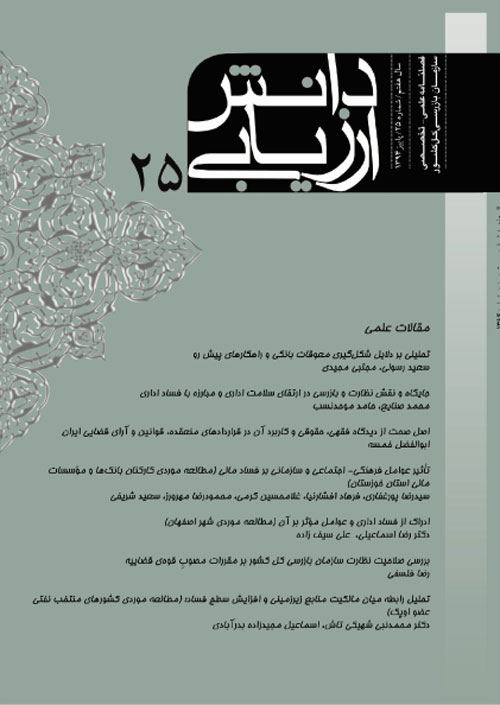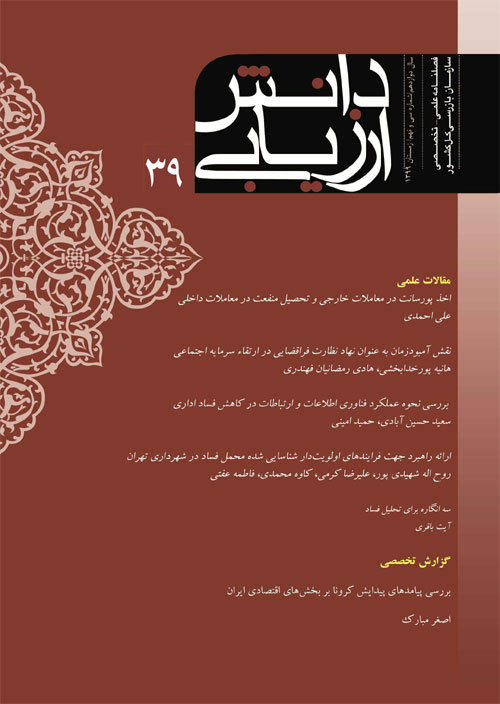فهرست مطالب

فصلنامه دانش ارزیابی
پیاپی 25 (پاییز 1394)
- بهای روی جلد: 50,000ريال
- تاریخ انتشار: 1394/09/15
- تعداد عناوین: 8
-
صفحه 1
-
ادراک از فساد اداری و عوامل موثر بر آن / مطالعه موردی: شهر اصفه انصفحه 73
-
تحلیل رابطه میان مالکیت منابع زیرزمینی و افزایش سطح فساد / مطالعه موردی کشوره ای منتخب نفتی عضو اوپکصفحه 115
-
Page 5Current amount of Non-performing loans in Iranian banking system has caused blocking of about 20% of total liquidity. By refer to statistics, Non-performing loans approximately consist of 14%- 15% of total credits of banks in Iran that is up to fourfold of the global norms. So, Non-performing loans became a real impasse in Iranian banking system and it is necessary to attempt for solving this problem by researching its reasons. In this article we explore and categorize reasons of shaping non-performing loans. Results show that managing deviations, decision-making mistakes and legislation problems are the main reasons of this condition.Keywords: Non, performing loans, Iranian banking system, General Inspection Organization
-
Page 21Monitoring and inspection are two instruments for management system that have controling, deterrence and corrective role. It is defined the proper implementation of operational activities and to ensure compliance with laws and regulations and to achieve the desired goals and objectives and programs of every organization. The fight against corruption requires preventive and deterrent measures while, for the promotion of the administrative integrity, it is needed to adopt the initiatives which in addition to maintaining the current state of administrative integrity it. The article 28 in the law of integrity Promotion of administrative system, obliges The Council of national regulators to prepare the standard indicators for measuring the administrative integrity. The council approved the nine indicators, including: Rule of law, establishment and development of electronic systems, transparency, oversight and internal controls, accountability, administrative and financial discipline, training, skills, development of religious culture and ethics, meritocracy and consumption patterns and productivity. Moreover, participation, accountability and justice are among those indicators that affect the administrative integrity and increase administrative efficiency, ensuring the proper implementation of laws.Keywords: inspection, control, the administrative integrity, the administrative integrity indicators
-
Page 59This study has investigated the role of socio-cultural and organizational factors on financial corruption among employees of banks and financial institutions in Khuzestan. The study populations are 15,000 employees of financial institutions, among which 384 people were selected as sample using stratified random sampling method and Cochran sampling formula. The data collected through interviews with top managers in the first part and a questionnairein the second part. Experts confirmed the validity and calculated reliability through Cornbrashs alpha and Guttmann were 87/0 and 86/0 respectively. Results showed that the average impact of organizational and socio-cultural factors on financial corruption was 09/4 and 98/3 higher than the average. Organizational factors with an average of 62/1 have also a greater share in the creation and control of corruption than socio-cultural factors. According to the results the elements of Organizational Culture has a greater share in the creation and control of administrative corruption. Results also showed a significant difference between the respondents views on organizational factors in terms of education, Career history and socio-cultural factors in terms of education and Career history.Keywords: Corruption, financial corruption, culture, organizational factors, cultural factors
-
Page 73Corruption is a constantly changing phenomenon and which is influenced by various factors such as socio-cultural, institutional and organizational structures, structural policies and economic and political environments. Corruption as a form of social deviance among the main obstacles of economic and social development in communities. Corruption has two important aspects. The first is perception of corruption in society. The other is the indicators for measuring and evaluating it. The aim of this study was to investigate the perception of corruption and its determinants in Isfahan province. In this study, a questionnaire survey was used. The random sampling method used and the sample size is 394 to include an assessment of the validity and Cronbachs alpha was used to calculate reliability. The results using SPSS software is both descriptive and analytical extracted. The results show that: (1) there is a significant difference between men and women in perception of corruption.(2) there is a significant difference in perception of corruption concerning the level of education and marital status of respondents. (3) there is no significant difference between ageand socio-economic status of the respondents and their perceptions of corruption.Keywords: corruption, perception, perception of corruption
-
Page 91This research tries to to answer the principle question considering that does the GIO as one of the subsidiary bodies of the judiciary have it Supervision Competency on the provisions of the Judiciary Act? This study believes that such Competency exists for the GIO and proves it concerning the principles of the constitution, the Guardian Councils interpretation views and GIO.Keywords: Supervision, Judiciary Act, GIO
-
Page 115This paper examines the relationship between the abundance of natural resources such as oil and corruption in OPEC countries using panel data and fixed effects model in the 2003-2013 period. Besides the oil resource abundance index of variables such as the rule of law, government effectiveness and GDP per capita is used as control variables. The regression results show that there is a negative relationship between the explanatory variables (abundance of oil resources, government effectiveness, the rule of law, and GDP per capita) and the corruption so that the increase in them, reduced corruption. Given the strong negative relationship between the rule of law and government effectiveness obtained with corruption index, The overall result of this research can be as stating that abundant oil resources itself does not give rise to corruption, but the reasons for taking other factors such as indicators of good governance.Keywords: Corruption, Rule of law, government effectiveness, Natural Resource Curse, panel data model


